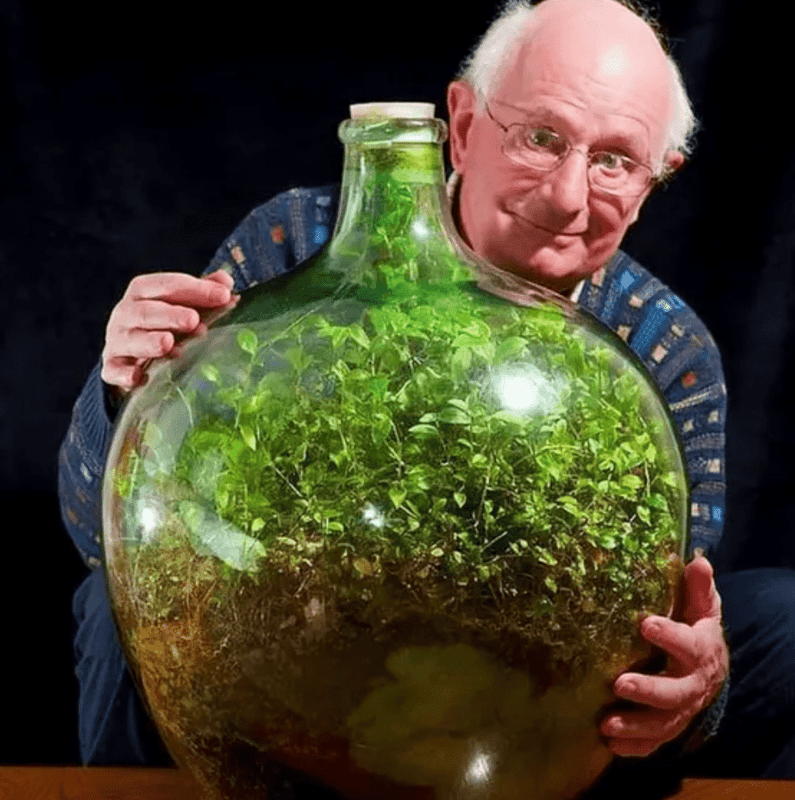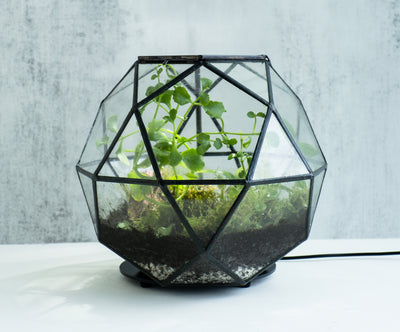
The Oldest terrarium was made by David Latimer in 1960 and has since become the world’s oldest terrarium. This self-sustaining bottle garden has flourished for decades without watering or any other help. He claims that he watered it only once in 65 years. In this article, learn how it works and why it’s significant.
Quick Facts
-
David Latimer’s terrarium, created in 1960, is a self-sustaining ecosystem that has needed no maintenance for over 65 years.
-
David Latimer's terrarium is not the oldest ever living terrarium. The Earth itself is the oldest known living terrarium. 🙂
-
Creating your own terrarium basically follows Earth's ecosystem. This will help you to learn about how eco-systems and sustainability work.
-
BONUS: Check out my oldest terrarium at the end of the post
Inside the World's Oldest Terrarium
David Latimer’s sealed glass bottle terrarium is a self-sustaining wonder. This sealed bottle garden shows what can be achieved in a closed environment. But of course, so many things went right. It is not just because he knows all the secrets of making 65-year-old terrariums. If it were the case, we would have so many more 30-40 years of terrariums today.
He created his terrarium from a plant cut a long time ago, and the plant covered all the bottles over the years. Maybe so many times, all the leaves died and flourished back; we don't know.
Did he ever open?
Yes, he opened it just once in 1972, and it has thrived without external intervention for decades.
Earth is the oldest terrarium

Earth is the world’s oldest sealed terrarium, and it is around 4.5 billion years old. If you think about it, making a closed terrarium that lives over a year is even a very hard task, but Earth is still alive and still self-sustaining for 4.5 billion years. We are living in a perfectly set up terrarium. So many cycles are working seamlessly on Earth, such as recycling carbon dioxide, water vapor, and nutrients to support life.
Each spring, when the forests thaw, they become massive carbon sinks, absorbing carbon dioxide from the atmosphere and releasing oxygen, just like the living plants in a small terrarium. Studying these natural processes on Earth gives us valuable insights into creating and maintaining terrariums, showing us how everything is connected and how to preserve the balance.
David Latimer’s Sealed Garden
David Latimer’s sealed bottle garden started with a simple question in 1960 when he decided to create a sealed terrarium in a 10-gallon bottle with water, compost, and spiderwort seeds.
He didn’t know it would become a living proof of self-sustaining ecosystems.
Setup
Latimer’s terrarium was filled with a quarter pint of water, compost organic matter, and spiderwort seeds. The 10-gallon glass bottle was the perfect environment for this mini-ecosystem.
Choosing spiderwort, a plant that thrives in closed environments, was the key to the terrarium’s success.
Accidental Experiment
After sealing the bottle, Latimer’s terrarium was left unopened for over 10 years, an unintentional experiment in self-sustainability. In 1972, he opened it to add some water, which was the only maintenance it had since it was created.
The humidity inside the sealed terrarium is what keeps the ecosystem going.
Understanding the Self-Sustaining Ecosystem

Latimer’s terrarium is a self-sustaining ecosystem. Unlike other terrariums that need regular human intervention, sealed terrariums like his rely on closed ecological cycles to balance and support life.
This mini-garden shows nutrient and water cycling in action with minimal maintenance.
Photosynthesis and Respiration
Photosynthesis and respiration are the heart of the self-sustaining ecosystem in a sealed terrarium. Plants convert carbon dioxide into carbohydrates through photosynthesis, storing energy as ATP. Bacteria break down organic matter, releasing carbon dioxide during respiration, which plants use.
This continuous chemical reaction allows the plants in the terrarium to live.
Nutrient recycling and water cycling are key in Latimer’s ecosystem. Water cycles through the plants as they absorb it through their roots, transpire it into the air and it condenses back into the substrate. Organic matter breaks down and plants recycle the nutrients needed for growth.
This is nature’s efficiency.
David’s Sealed Garden’s Longevity
David’s garden has been going for over 50 years without external watering, relying only on its internal environment. This closed system has maintained moisture and supported plant life.
Longevity Factors
Several things contribute to David’s garden’s longevity. Constant humidity in the terrarium supports plant life. Water cycles through the plants as they absorb it, evaporate it and it condenses back into the soil, keeping moisture in and preventing dehydration.
This closed environment keeps the ecosystem balanced and self-sufficient.
Compared to Traditional Terrariums
Traditional terrariums need regular maintenance and human intervention for watering and nutrients, while sealed terrariums are self-sustaining, keeping the traditional terrarium’s essence. Constant humidity and water vapor circulation are what make sealed terrariums long-lasting, not traditional setups that deteriorate over time.
Sealed terrariums use specific plants and soil mixes that are low maintenance, more so than traditional ones.
Creating Your Own Sealed Bottle Terrarium

Making a sealed bottle terrarium is a simple, low-maintenance setup that brings a self-sustaining ecosystem into your home. Choosing the right bottle, plants, and potting mix will give you a thriving mini-garden with minimal maintenance.
I have been making terrariums for a long time and here is my guide on Learning how to make a closed terrarium
Choosing the Right Glass Bottle
Selecting the right glass bottle is more important than it sounds. A 6.5-gallon size is what Latimer used. Make sure to clean the bottle if you are buying the jar from a thrift store. I wrote a very detailed terrarium containers article here.
Selecting Plants and Potting Mix
Choosing the right plants and potting mix is critical. Slow-growing plants like ferns or moss require minimal maintenance. Same light and moisture requirements for better compatibility.
The potting mix is also very important to plant health, providing the nutrients for growth, but the plant is the key to making a long-living terrarium. Check out our suggested terrarium plants.
Maintaining the Perfect Conditions
Keeping it perfect is key to long-term success. A balanced environment with the right light, humidity, and nutrients will make plants moist and happy.
Regular checking and minor adjustments will keep the self-sustaining ecosystem.
Read how to keep your terrarium alive.
The Fascination with Sealed Terrariums

Sealed terrariums are fascinating because they are self-sustaining ecosystems, that require no care. You basically create a small small Earth in your house.
Connection to Nature
Sealed terrariums allow you to connect with nature indoors, to be tranquil and appreciate the environment. These mini ecosystems bring the beauty of plants into your living space, a tangible way to experience nature without having to go outdoors.
Latimer’s experiment has inspired many gardeners to go green.
Educational Value
The educational value of sealed terrariums is huge. Watching the continuous cycles of photosynthesis and respiration in a sealed environment will give you insights into ecological principles, and you’ll understand the balance and the interplay between plants and their environment.
Sealed terrariums give you a chance to study plant life cycles, the cycle of life in a closed terrarium.
David Latimer's Legacy
David Latimer’s garden is considered a landmark in horticulture. His experiment proved self-sustaining ecosystems and modern gardening practices are all about sustainability and being in harmony with nature.
This legacy continues to inspire gardeners and horticulturists around the world.
Future
Sealed terrariums are used in ecological research and education, to study self-sustaining ecosystems. They provide data for environmental sustainability, especially in controlled environments.
In space exploration, sealed terrariums can be used in life support systems for long missions, like a space station, as contained ecosystems.
Bonus: Victorian Era Terrarium
Terrariums are not a modern phenomenon. In the mid-19th century, advances in engineering and glasswork allowed indoor cultivation of tropical plants in the UK. Victorian drawing rooms were filled with exotic plants, part of the aesthetic of the era. Nathaniel Ward’s invention of the Wardian case revolutionized indoor gardening by creating hermetically sealed glass bottles where plants, especially ferns, could thrive in polluted environments.
The Wardian case greatly improved the survival rate of tropical plants during transport, from 95% mortality to 5%. This led to a fern collecting craze, known as ‘Pteridomania’ which swept all social classes.
Terrariums became a popular gardening method during the Victorian era, as people loved unique plant displays and the symbolism of different plants and flowers.
Conclusion
David Latimer’s sealed bottle garden is a self-sustaining ecosystem that has been thriving for over 60 years without any external help. This post has covered the history and science behind this terrarium, the principles of self-sustaining ecosystems, and how to create your own sealed bottle garden. By understanding the processes that sustain life in a closed environment, we can appreciate the beauty and efficiency of nature’s perfection. Let David’s garden inspire you to have your own self-sustaining ecosystems at home.
My Oldest Terrariums
I have been making terrariums for years and I would like to share my oldest closed terrariums with you.

I made this terrarium in April 2023. Never watered and never opened even once.

This fern terrarium has been closed for over 1,5 years and it grew 20 times since I planted just one fern. It is quite healthy. Also, you can see some moss formation, which is the most magical thing for me in a closed terrarium. I watered it once.

This Mars dome-shaped closed terrarium is fairly young. She is about 10 months old and super healthy. I opened it a few times and added some springtails.

5 months old mini terrarium. As you can see it is already outgrowing.
How did David Latimer create his sealed bottle terrarium?
David Latimer created his sealed bottle terrarium with 1/4 pint of water, compost, and spiderwort seeds in a 10-gallon glass bottle. Brilliant way to show nature’s cycle in a closed environment!
Why has David’s terrarium lasted so long without maintenance?
David’s terrarium has lasted so long because the closed environment creates a closed ecosystem with constant humidity and recycles water and nutrients. It can survive on its own!
What’s the difference between a terrarium and a sealed terrarium?
A terrarium needs regular care, a sealed terrarium creates a closed environment, so you can enjoy it with minimal effort! Love low-maintenance greenery!
Can I make my own sealed terrarium at home?
Yes, you can make your own sealed terrarium at home! Just choose a glass container, add some plants and the right potting mix and you’ll have a beautiful low maintenance ecosystem.
If David’s children don’t want to inherit the world’s oldest terrarium, it will be passed to the Royal Horticultural Society in London to preserve this horticultural wonder.
Check out our terrarium starter kits.
What are the educational benefits of a sealed terrarium?
You can learn ecological principles like nutrient cycling and photosynthesis with a sealed terrarium. Hands-on learning for sustainable living!
Check out our terrarium starter kits.



5 comments
I happened to have the same idea as Dr. David Latimer. But I used it to test some chemistry theory. I wonder if I can find others who did the same experiment so we can analyze the results together. Can anyone help me find the same example others are testing?
what AI schlock
GREAT ARTICLE! THANK YOU SOOO MUCH!!!!
A really interesting article!
Beautiful informative article, thank you!!